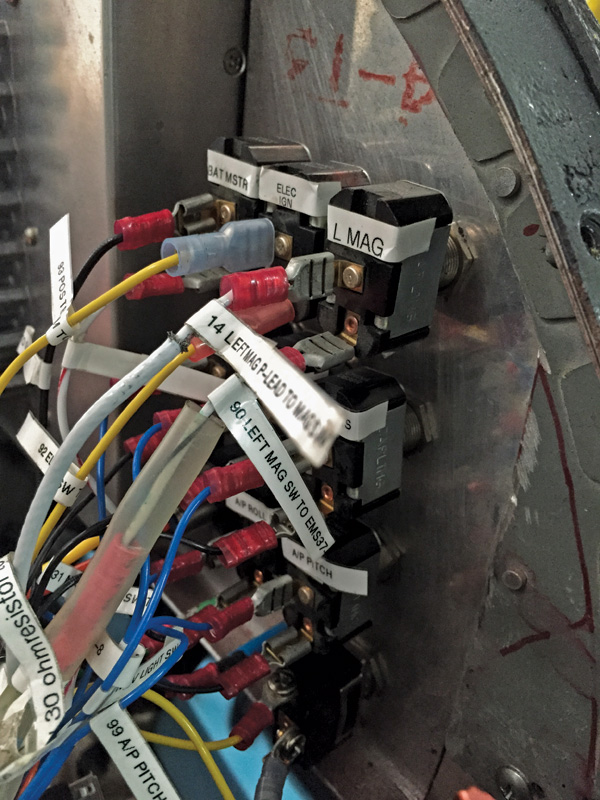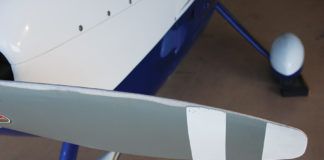Most pilots I know are all well aware of the cliches about “every flight being a learning experience,” and “don’t let the bag of luck run out before you fill up the bag of experience.” In fact, most of the pilots I fly around with really exemplify their commitment to safety and strive to learn from others’ mistakes. And sometimes a chain of events that could lead to an accident has a better outcome, sometimes through luck, and sometimes through best practices. In this column, I am going to share with you several recent events that happened to me, the first of which had Lady Luck and best practices clearly working overtime for me.
The offending item. Look closely and you will see that the only two wires to the switch are the P-lead and the tach lead to the VPX.
It’s been a busy year for pre-purchase inspections, and it’s a part of my business that I really enjoy, as I get to meet new people and see lots of different airplanes. A little over a week ago, I performed an inspection on an RV-4 that had been built in 2000. It turned out to be a well-built airplane with a really fancy paint job. The only area that gave me pause was that the engine compartment really needed some TLC. All of the hoses were at least original from the build in 2000, and some were perhaps even older, as the engine had 1600 hours on it SMOH, 900 of it on this RV-4. It turns out the builder had scavenged the engine from a Cessna Cardinal that had been in an off-runway accident, totaling the aircraft. My recommendation was that the new owner have a knowledgeable person replace the life-limited components in the engine compartment immediately.
The same switch properly wired with a ground. Also note that the switch is turned around so that an “up” on the panel side is really an open switch. The magneto is switched to ground when the switch is in the down position.
Within the next few days, the seller and the buyer came to an agreement, and the new owner asked if I would be willing to pick up the airplane, thoroughly inspect it, replace whatever was necessary, and then deliver it to his home base in Florida. I agreed to do the work and the stage was set. A friend and I flew his RV-8 to North Georgia to pick up the airplane. After a thorough preflight, runup, and a couple of circles over the airport to verify all was normal, we departed for my place. Here’s where the chain started.
Ungrounded Magneto
This RV-4 had one electronic ignition and one magneto. It is not uncommon when doing an ignition check with this setup to see the rpm indication go to zero when switching off the magneto. The practice is to listen to the engine for smoothness and a check of EGTs will indicate a rise in temps. I didn’t notice any engine roughness at all, and I don’t remember checking the EGT indications. My bad. It was very hot this day, as it had been in the high 90s for weeks. Sitting on the ground in the sun in an RV-4 bubble canopy is not exactly pleasant, so I had performed a cockpit familiarity check in the shaded hangar in order to reduce ground time. Once airborne another distraction occurred—the cockpit heater was not fully closing! Even a climb to 5500 feet did not alleviate the ridiculously hot cockpit. I couldn’t wait to land, and when I finally did, I couldn’t get the canopy open fast enough to extricate myself from the cockpit. Because of my discomfort, I rushed the shutdown and neglected to perform my usual ignition grounding check. Can you see what’s coming?
Over the course of the next few days, I replaced just about everything on the forward side of the firewall, including hoses, plugs, spark plug wires, etc. I even performed a prop balance and properly set the ignition timing, all of which required rotating the propeller. During the ferry flight, I thought the engine ran a little hot for a 1600-hour engine and sure enough, the timing was advanced way too far. The new owner also wanted some avionics additions, so I completed those as well. About five days later, I was ready to run the engine and test-fly it. The startup and systems checks were normal until I performed the grounding check on the ignition systems. The engine remained running when I switched the magneto to the off position! Yep. No matter how many times I switched it off, it remained running. You can probably imagine how badly I wanted it to quit running when I flipped that switch. It stubbornly refused to quit!
I wasn’t quite shaking, but I assure you, I was shaken. For the last few days, I had moved that prop multiple times. This is where best practices worked. I am always careful to never be in the prop arc when moving it. This is especially critical when timing the engine, as the ignition is switched on in order to time the magneto, as well as the electronic ignition. And when doing a prop balance, I visually verify the ignition is off before I ever touch the prop, I rotate the prop backwards when adding weights, and the airplane is tied down if I am doing it solo.
The actual cause was very interesting to me, and you can see it in the pictures. This particular airplane was never wired properly from the beginning. In fact, there never even was a ground wire installed to the magneto switch. The P-lead from the magneto was wired to the switch, and that switch was wired only to the VPX (Vertical Power) rpm input signal. I realized I wasn’t the only lucky one here! I could only imagine how many people throughout the 15-year life of this airplane had Lady Luck smiling on them and they didn’t even know it. And shame on the pilots for never doing a grounding check!
I wired the switch properly and made a pleasant call to the seller explaining it to him just in case he ever wires another airplane. This is now my second time experiencing an ungrounded magneto in my life. I really hope I never experience a third one!
The owner was complaining of intermittent VPX errors. Upon chasing the signal wire down, I found it to be really poorly stripped and shorted. It’s now properly fixed, and all is well!
By the way, this same RV-4 was giving intermittent VPX errors until I found the cause: a really poorly stripped serial data signal line. Once I repaired that, it was nice and solid.
The second recent learning experience is almost funny after the fact, but really had me confused while it was occurring. I had flown my RV-10 to Florida to license a couple of new airplanes and was heading back home. I was in South Georgia at 12,000 feet on an IFR flight plan listening to JAX center, when all of a sudden I hear Atlanta Tower just as clear as if I was on final approach to KATL. They were their usual beehive of activity, and I also heard them talking to Falcon Flight, which happens to be a group of RV guys at Falcon Field in Peachtree City, Georgia, that I fly with. At first I started wondering what function was happening at KATL with the Falcon Squadron that I didn’t know about. So I continued to listen to the conversation, but after a few minutes, I realized there was so much chatter that I was having a hard time discerning the radio calls from JAX Center. I informed JAX that I was getting bleed over from Atlanta Tower, and they gave me a new frequency. Interestingly enough, I could still hear Atlanta!
iPhone Interference?
One of the axioms I try to practice in the cockpit when something goes awry is to take a breath and look at my watch. Not really to check the time, but just to pause before doing anything rash. In this case I asked myself from where could the interference be originating. I tried both com radios with the same results, and when I turned the volume down on each radio it was still loud and clear. Hmm…the only other electronics in the cockpit were my iPhone and the iPad running ForeFlight. Perhaps this is why we aren’t allowed to use phones on commercial airlines, I thought to myself. So I proceeded to power off the iPhone and instantly I ceased to hear Atlanta tower. I waited awhile to be sure, and then I turned the phone back on. Still nothing from Atlanta Tower. Well, that was interesting, I thought. I then restarted iTunes, which I had been listening to, and immediately Atlanta Tower was back! A quick glance at the iPhone, and the culprit revealed itself.
Last fall Delta was having their annual Maintenance Appreciation Day, and the Falcon Squadron was invited to display aircraft in one of the Delta hangars. It was a real fun experience to say the least. We took 17 Amateur-Built aircraft into Atlanta Hartsfield, and I took my Kitfox. What a hoot! Well, after the event someone had sent us the audio file of ATC in an email. Somehow that audio file ended up in my iTunes library and was now playing! I chuckled once I discovered it, but was embarrassed nonetheless. No one asked, and I didn’t volunteer any information, but I was happy when I got handed over to Atlanta!
The Chicago skyline really gets your attention, but one must be vigilant for the airliner traffic into Midway approaching from the east below the Class B. The routes are depicted on the area charts.
NOTAMs
As we are preparing for our trip to OSH this year, I was reminded of another lesson I learned last year on the flight home. We like to fly down the shore of Lake Michigan below the Class B and enjoy the beautiful Chicago skyline when the weather permits. One has to remember to keep the head on a swivel and watch for other traffic, especially big traffic. We were headed south and enjoying the view when I heard a traffic warning from the ADS-B. I looked and it showed traffic at 10 o’clock and very close. Hmm…I hadn’t seen anything over there, so I moved my head a little better forward to improve the view around the doorpost, and there was a really big 767 airliner right there! No time to look at my watch for this one—I quickly dove down a few hundred feet, and I’m sure it looked closer than it was. I quickly started reviewing our position on all 3 GPSes and confirmed visually that we were below the Class B. While I usually use flight following, Chicago was very busy that day, and we hadn’t been able to connect. This is where the lesson was learned again, and as an Instructor, I knew this. The Class B only separates the traffic going in and out of the primary airport (O’Hare International). This airliner was headed to Midway. And a review of the NOTAMs showed that Chicago Tracon had made a note for all OSH traffic to be aware of the new VFR approaches for heavy jets in and out of Midway. The Notam was there, but really buried in a very long list. I will be paying closer attention this year!
So there you have it. In the first example I really pressed Lady Luck to keep looking out for me. I also think it continues to give credence to my belief that someone other than the builder should look over the airplane using a checklist during the first year. I am willing to bet that this is not the only aircraft wired this way.
As for the iTunes and Chicago events, I’ll just file them in the experience bucket under the “There I Was” category. I’d also bet that some of you have similar stories with no harm/no foul that presented a lesson learned, and perhaps you have never told anyone.
Talk to you next month.

![]()
Vic Syracuse is a Commercial Pilot and CFII with ASMEL/ASES ratings, an A&P, DAR, and EAA Technical Advisor and Flight Counselor. Passionately involved in aviation for over 36 years, he has built nine award-winning aircraft and has logged over 7500 hours in 69 different kinds of aircraft. Vic had a career in technology as a senior-level executive and volunteers as a Young Eagle pilot and Angel Flight pilot. He also has his own sport aviation business called Base Leg Aviation.

















